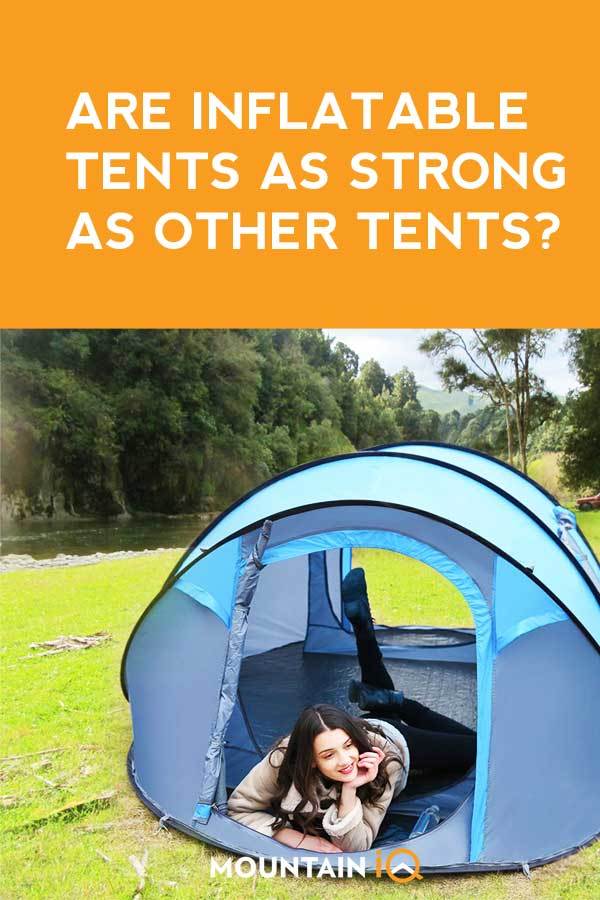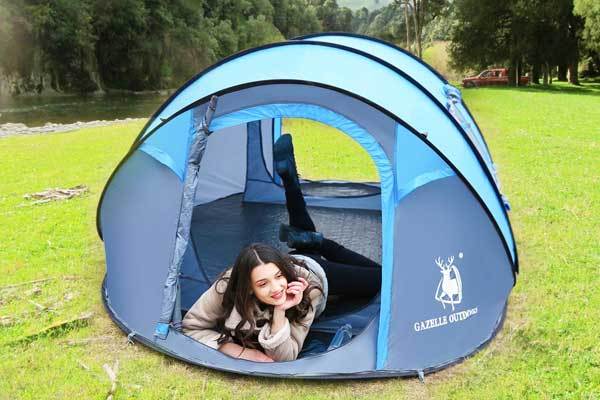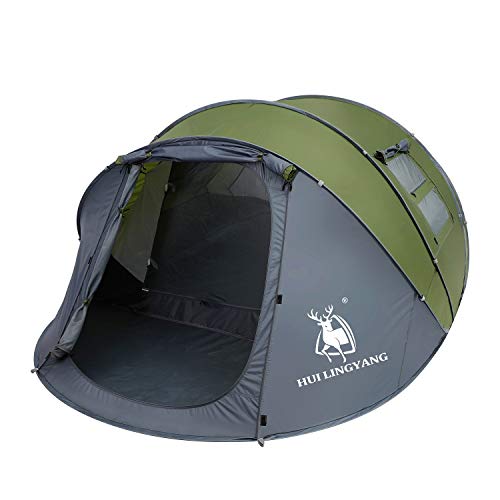Inflatable tents significantly reduce the time you spend pitching your tent and are great for family camping trips as they come in big sizes.
Unlike regular tents or pop-up tents, inflatable tents have inflatable beams instead of the fiberglass or metal poles. So, to set one up, just unroll or unfold the tent, pump it up, peg it down, and you're good to go.
Best Inflatable Tents (Top Picks)
Best Overall
Best Value
Best Lightweight
This article contains affiliate links. If you buy something through the links on this page we might get a small commission. It will not affect your price, but helps keep our site alive!
Top Inflatable Tents For Camping
Here are my top 6 picks for the best inflatable tents:
- Vango Voyager 400 Tunnel Tent - Best Overall
- Vango Venture 450 Tunnel tent - Most Spacious
- Tangkula Inflatable Tent
- Heimplanet Backdoor
- Heimplanet Dome Tent - Best Lightweight
- Hui LingYang Instant Tent - Best Value
Read our complete buyers guide for inflatable tents.
Best Overall Inflatable Tents
1. Vango Voyager 400 Tunnel Tent
The Vango Voyager 400 Tunnel Tent is a great option for a family or group wanting a quality product that will stand up to multiple camping trips.
The Vango Voyager is by no means cheap, but the balance between innovation and design by Vango offers up a sturdy and rugged tent, making it well worth the investment.
Check Prices
Main Features
What we like
What we dislike
2. Vango Venture 450 Tunnel Tent 4
The Vango Venture 450 Tunnel tent provides 143 square feet (13.2 square meters) of space. With three rooms and a porch, this tunnel tent is the perfect family or small group tent.
The Vango Venture is not freestanding, and will have to be staked. All stakes and guy lines are included. While inflatable, the front porch does make use of a traditional fiberglass pole.
Check Prices
Main Features
What we like
What we dislike
3. Tangkula Inflatable Tent
The Tangkula Inflatable tent is a fast setup, mid-priced 2-3 sleeper tent. Taking only 3 minutes to inflate, it provides a spacious sleeping area and a covered porch for gear storage.
Taking this tent down is just as easy, simply open the valve and let the air out.
Check Prices
Main Features
What we like
What we dislike
4. Heimplanet Backdoor Tent 4
If you can afford it, the Heimplanet Backdoor offers space-age design with many practical features.
Sleeping four to six people, it has two rooms separated by a vestibule in the middle. For such a large tent, it takes just 60 seconds to inflate and weighs a compact 13 pounds (6 kg).
Check Prices
Main Features
What we like
What we dislike
5. Heimplanet Dome Tent
The Heimplanet Dome Tent is perfect for the avid camper or adventurer. This compact, lightweight and easy to set up inflatable tent can stand up to just about anything.
The Inflatable Diamond Grid (IDG) ensures stability; this is a freestanding tent so it can be set up wherever you want. Guylines are included to allow you to stake it to the ground if needed.
Check Prices
Main Features
What we like
What we dislike
6. Hui LingYang Outdoor Instant Tent
The Hui LingYang Instant Tent is ideal for the occasional camper on a budget. It is, however, not recommended for anything other than fair weather.
Available in a range of colors, this is an affordable and compact piece of gear to have for those unexpected occasions when just a simple tent will do.
Unlike the other tents we have reviewed, this is an instant popup tent, so no pumping is required.
Check Prices
Main Features
What we like
What we dislike
The Bottom Line
For something a little more rugged and wet weather capable, consider the Vango Voyager 400 Tunnel Tent. It is constructed from superior waterproof materials and rated to 4000mm. Factory taped seams add to the overall waterproof rating of this tent.
The budget friendly Hui LingYang Instant Tent is more of an occasional tent suited for fair weather. It does not have the waterproof ratings of the other tents but it is an instant tent that pops up in a matter of seconds. Kids will love this one too.
If it’s space you’re after, the Vango Venture 450 Tunnel tent has a lot of it. Rated a four-person tent, it has 143 square feet (13.2 square meters) of space. With a dedicated sleeping area, a sitting area and a covered patio, this is ideal for longer camping vacations.
For a balance between affordability and function, the Tangkula Inflatable Tent is a medium sized tent that takes just 3 minutes to inflate. It's a relatively small tent, so it's not ideal for bigger camping groups, but with its durable polyester and PU coating, it’s a great addition to your family’s outdoor gear.
The Heimplanet Dome Tent is super lightweight and sets up quickly, but it does come with a rather hefty price tag. The larger Heimplanet Cave gives you a little more space, but it also weighs nearly twice that of the Heimplanet Fistral.
Both Heimplanet tents benefit from the Multi-Chamber Safety System, which means each beam functions separately. So if one beam is damaged the integrity of the structure is not totally compromised. You can also repair or replace each part separately.
If you’re a person who is prepared to make an investment, the Heimplanet Backdoor is an option for you. This large, 2-room tent sports a futuristic structure that incorporates a traditional tunnel tent and a geodesic dome design. With 107 square feet (10 square meters) of space, it is actually quite light, weighing just under 13.5 lbs (6 kg).
Inflatable Tent - Buyer's Guide
What is an inflatable tent?
Inflatable tents (or air tents) are becoming increasingly more popular because, like pop up tents, they are quick and easy to set up. But what exactly is an inflatable tent?
An inflatable tent makes use of inflatable beams as opposed to the usual fiberglass or metal poles that most tents utilize. This means that all you need to do is unroll or unfold the tent, pump it up, peg it down and you're done!
Inflatable tents significantly reduce the time you spend pitching your tent and are great for family camping trips as they come in big sizes.
Are inflatable tents as good or strong as other tents?
Inflatable tents are designed with stronger materials so that they can last just as long as any other tent would. This is why they also tend to be more expensive than regular tents. They need to ensure that their inflatable beams are durable so that they won't puncture easily and cause the whole tent to collapse.
If you do get a puncture in one of the inflatable beams, it is very easy to fix as you'll just need to patch it up with some repair tape and then pump it back up again.
Some of the more expensive, high quality inflatable tents can also withstand heavy wind and rain so you can go camping in any weather conditions. Any type of tent could struggle in bad weather so if you frequently camp in harsher conditions, make sure you invest in a higher quality, waterproof tent that is designed to withstand any type of weather.
Materials and Durability
A higher quality tent will generally have higher quality fabric. In most cases, the manufacturer will use a waterproof fabric like a polyurethane coated polyester. Denier(D) and thread count (T) are terms often used to indicate stronger fabrics so look for a higher number, i.e. 120 denier is thicker and stronger than 70 denier.
Other Features of Inflatable Tents
Size
Whether you're a solo camper or looking for something for your family or a group, always consider the manufacturer's occupation rating as a guideline only. For the sake of comfort, opt for actual number of people + 1 (or even + 2).
The tent style will dictate the actual floor space and the height clearance of the tent. Generally dome tents offer the least usable space and height, while a tunnel tent will provide better headspace.
Portability
If you’re backpacking and you need something light, look for a tent that packs up small and doesn’t weigh that much. Bear in mind that if you get an inflatable tent you'll need to pack a pump as well. What you save in weight from not having to carry poles, will be made up with the pump, so be mindful of the size and weight of your pump as well.
Inflation and Deflation
How quickly an inflatable tent inflates will depend on the pump you’re using and the size of the tent. The inflation time of the tents reviewed range from 60 seconds to 10 minutes. Inflatable tents are generally much quicker to set up than tents with poles and multiple separate parts, so if you're looking for a quick and easy setup, an inflatable tent is a great choice.
Deflation and packing away is generally tougher than inflating and setting up an inflatable tent. Follow the manufacturer's instructions to get all the air out and fold the tent to fit into the bag properly to avoid damage.
Footprints
Most inflatable tents will include a built-in groundsheet. If you’re camping on particularly rocky or wet terrain, it might be advisable to use a separate footprint or tarp.
Accessories
The most obvious accessory required for an inflatable tent is a pump. When purchasing an inflatable tent, check if a pump is included. Even if a pump is included, you may want to use something else so make sure that the tent valves and the pump match. If not, you will need to get an adapter for your pump.
Next you will need a repair kit. Unlike a traditional tent, if you have a rip or hole in an inflatable tent, it can be fixed. Make sure that you have a repair kit and, just as importantly, that you know how to use it. Remember to always check the state of your repair kit before your camping trip. If it’s been used, you may need to replace patches or glue that has dried out.
Continue browsing
See more outdoor gear reviews and our detailed camping tent guide. Or check out these reviews:



![Vango Voyager 400 Tunnel Tent [Amazon Exclusive], Under 5 Mins Easy to Pitch 4 Man Tent Waterproof for Adventure Camping, River Blue](https://m.media-amazon.com/images/I/41x9EWa3h4L.jpg)


![Vango Venture 450 Tunnel Tent for 4 People [Amazon Exclusive] with Large Porch Living Area - Waterproof, River Blue](https://m.media-amazon.com/images/I/31OVaYjXyzL.jpg)

